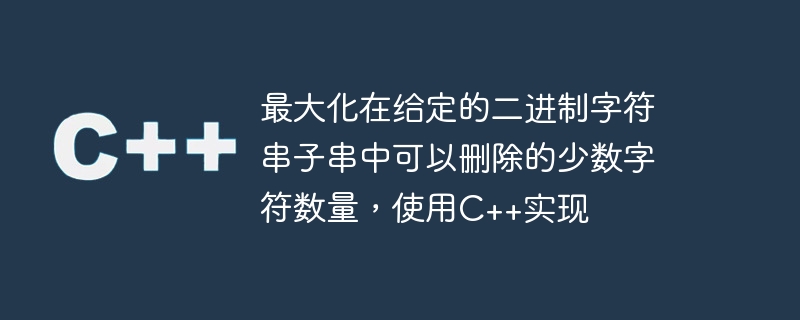
Our current undertaking involves maximizing the number by which we can delete any occurrences containing the minority character(s) within a section comprised entirely by either '0' or '1'. The end goal is simply to reach maximum possible deletions while still respecting all given rules and constraints.
To ensure a comprehensive understanding of the upcoming codes let us first familiarize ourselves with the syntax of the method that will be employed before exploring the algorithm and strategies −
int maximizeDeletions(string binaryString, int startIndex, int endIndex)
最大化给定二进制字符串子串中少数字符删除的算法可以通过以下步骤描述:
首先,让我们通过将一个名为 deletions 的变量初始化为零来开始。这个变量的主要目的是监控发生的删除操作的计数。
立即学习“C++免费学习笔记(深入)”;
确定二进制字符串的特定子字符串中数字'0'和'1'出现的频率。可以分别计算这些数字的每次出现。
To pinpoint the minority character(s), we must refer to the counts obtained in the previous step.
从子字符串中删除所有次数较少的字符,并相应地更新删除计数。
将删除的最终值作为结果返回
The execution of our approach involves traversing through the binary strings substring in a linear fashion and then deleting the minority character(s) all at once.
#include <iostream>
#include <algorithm>
using namespace std;
int maximizeDeletionsLinear(string binaryString, int startIndex, int endIndex) {
int countZero = 0;
int countOne = 0;
for (int i = startIndex; i <= endIndex; i++) {
if (binaryString[i] == '0') {
countZero++;
} else {
countOne++;
}
}
int deletions = endIndex - startIndex + 1 - min(countZero, countOne);
return deletions;
}
int main() {
string binaryString;
int startIndex, endIndex;
cout << "Enter the binary string: ";
cin >> binaryString;
cout << "Enter the start index: ";
cin >> startIndex;
cout << "Enter the end index: ";
cin >> endIndex;
int deletions = maximizeDeletionsLinear(binaryString, startIndex, endIndex);
cout << "Maximum deletions: " << deletions << endl;
return 0;
}
Enter the binary string: 1011010011 Enter the start index: 2 Enter the end index: 8 Maximum deletions: 2
在方法1中,我们利用线性遍历来最大化从给定二进制字符串子串中删除少数字符的数量。通过遍历指定的子串,我们可以确定在该部分内每个实例的'0'和'1'出现的次数。在确定该区域或组内较少频繁出现的字符(即找到"少数派")之后,我们可以通过从该指定区域内所有字符的计数中减去它们各自的计数来计算可能的删除次数。
这导致了一种有效的方法,可以揭示简单但实用的解决方案 - 只需要对我们的初始字符串进行一次遍历 - 这使得这种方法特别适用于较短的输入字符串。
The sliding window technique is another efficient approach to solve this problem. It involves using a window of fixed size to traverse the substring of the binary string
#include <iostream>
#include <algorithm>
using namespace std;
int maximizeDeletionsSlidingWindow(string binaryString, int startIndex, int endIndex) {
int left = startIndex;
int right = startIndex;
int countZero = 0;
int countOne = 0;
int deletions = 0;
while (right <= endIndex) {
if (binaryString[right] == '0') {
countZero++;
} else {
countOne++;
}
while (min(countZero, countOne) > 0) {
if (binaryString[left] == '0') {
countZero--;
} else {
countOne--;
}
left++;
}
deletions = max(deletions, right - left + 1);
right++;
}
return deletions;
}
int main() {
string binaryString;
int startIndex, endIndex;
cout << "Enter the binary string: ";
cin >> binaryString;
cout << "Enter the start index: ";
cin >> startIndex;
cout << "Enter the end index: ";
cin >> endIndex;
int deletions = maximizeDeletionsSlidingWindow(binaryString, startIndex, endIndex);
cout << "Maximum deletions: " << deletions << endl;
return 0;
}
Enter the binary string: Enter the start index: Enter the end index: Maximum deletions: 0
方法2涉及利用滑动窗口技术来最大化删除少数字符。使用固定大小的窗口,我们遍历子字符串,随着窗口的移动更新'0'和'1'的计数。通过根据计数调整窗口边界,我们识别出少数字符并计算可能的最大删除次数。这种方法通过高效地滑动窗口减少了冗余计算的数量,使其更适用于较大的输入,并提供更快的解决方案。
在本文中,我们探讨了如何从给定的二进制字符串子串中最大化删除少数字符的问题。我们讨论了两种方法 - 线性遍历和滑动窗口技术。这两种方法都提供了高效的解决方案来实现所需的结果。通过理解算法并研究提供的可执行代码示例,您可以将这些概念应用于解决自己项目中的类似问题。请记住要分析问题,选择最合适的方法,并相应地实施。
以上就是最大化在给定的二进制字符串子串中可以删除的少数字符数量,使用C++实现的详细内容,更多请关注php中文网其它相关文章!

c++怎么学习?c++怎么入门?c++在哪学?c++怎么学才快?不用担心,这里为大家提供了c++速学教程(入门到精通),有需要的小伙伴保存下载就能学习啦!

Copyright 2014-2025 https://www.php.cn/ All Rights Reserved | php.cn | 湘ICP备2023035733号